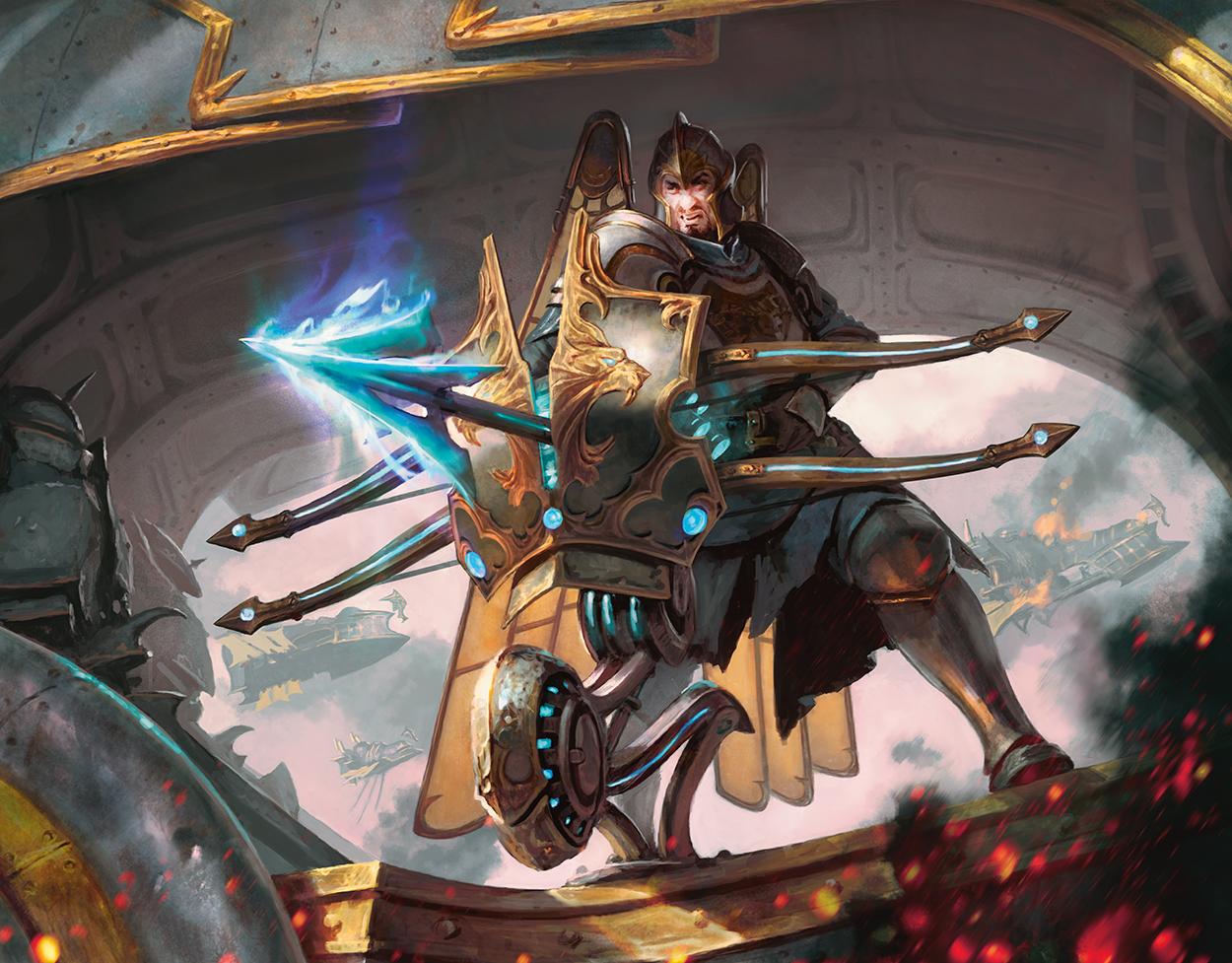Are you a Quiet Speculation member?
If not, now is a perfect time to join up! Our powerful tools, breaking-news analysis, and exclusive Discord channel will make sure you stay up to date and ahead of the curve.
It's not easy being blue.
The Brothers' War (BRO) is a format that can be hostile to slow decks as well as decks without removal. Blue comes up short in both departments. The color is not particularly aggressive, and the interaction leaves a lot to be desired.
Blue was nearly unplayable in some recent sets, namely Adventures in the Forgotten Realm (AFR) and Alchemy Horizons: Baldur's Gate (HBG). However, the color has far more to offer than it did in those limited environments. In BRO, blue is a support color, and while we shouldn't actively seek it out, when it is open for our seats, we need to know how to draft it.
This week, we'll be going through 17Lands recent trophy decks and analyzing how blue contributed to seven-win runs.
The Ugly Truth
One of the best reasons to get into a color is opening a singularly powerful card. Often times this occupies the rare slot, but this sometimes refers to high-powered uncommons. Unfortunately for blue, this color has only four total cards with a GIH WR greater than 60%.
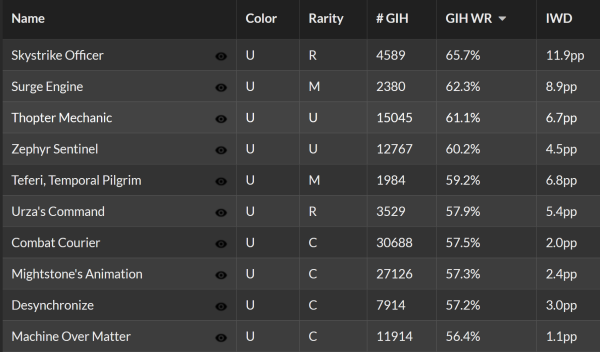
These cards just do not get it done. The fact that Desynchronize and Machine Over Matter are outperforming all but four rares and mythics is concerning. Additionally blue is the worst-performing color as a mono-color deck, with or without splashes.
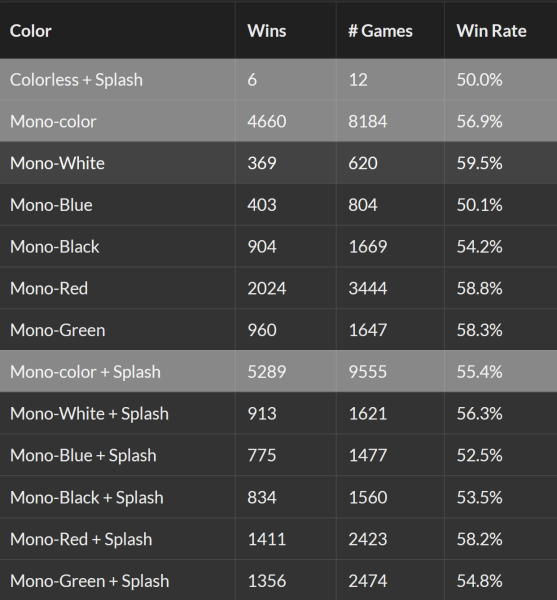
Finally, as we look at the more traditional archetypes in the format, blue is a partner in two of the lowest performers. Of note, UR Spells and UW soldiers are performing at a reasonable rate. UB and UG are decks we should try and avoid.
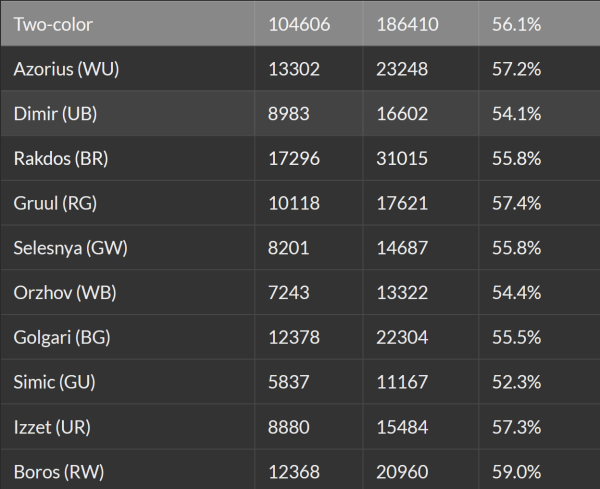
While blue isn't particularly strong in this format, we're going to analyze what the best decks are doing to optimize the blue cards they see in the draft. For this exercise, 17Lands provides a running list of the most recent trophy decks. We'll only be looking at decks that began their run in Platinum ranks or higher. While it may not be necessary to note, know that it takes more than a good deck to win seven games. The pilot matters.
Splashing for Bombs
The first deck that we're looking at, is dipping into blue for more than just a slate of playable commons. The draw into the color is coming from some of those high-powered cards we discussed earlier.
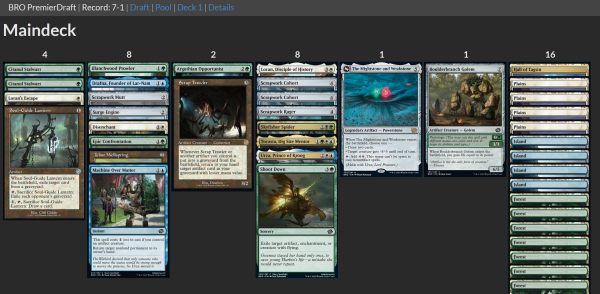
Bant Rare-Fueled Grindathon
This deck looks like a real treat to pilot. Generating value off of Drafna, Founder of Lat-Nam, Scrap Trawler, and Loran, Disciple of History is a powerful engine if we can stabilize. The double-Citanul Stalwart plan seems a little dubious, but this deck clearly got there and was able to take advantage of its high-powered endgame.
This deck introduces a common theme that we will see as we view the rest of the decks listed today. We don't want to get into blue for the commons. The card quality is not deep and if we're not seeing the top-end cards, blue won't be able to carry our deck.
Blue the Support Color
In these three decks, blue does what it does best in the format. It supports the plans of the other colors.
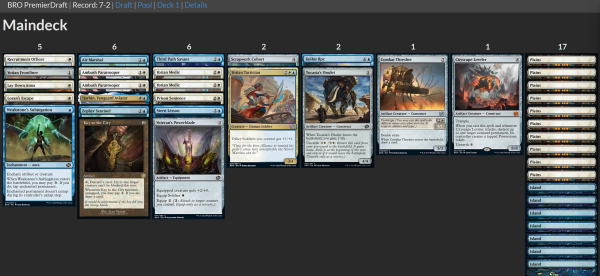
WU Soldiers and Powerstones
Blue adds some well-needed power to this aggressive white deck, capitalizing on soldier synergies. We see Yotian Tactician and Harbin, Vanguard Aviator supporting the go-wide Soldier theme. While the deck is almost all white cards, blue helps to provide the power boost at uncommon and rare to ensure this deck has the staying power to push lethal.
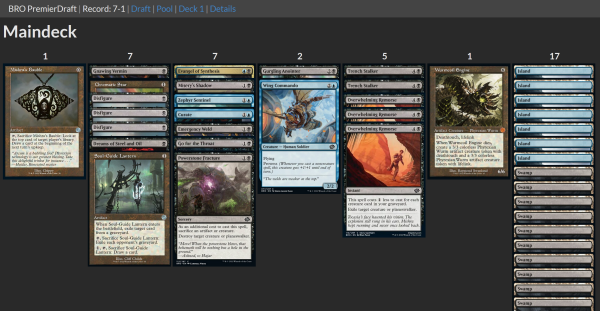
Bu Wurmcoil Control
This nearly mono-black deck looks to play a controlling role, ending the game with Wurmcoil Engine and double Trench Stalkers. These lifelinking threats are great for turning the corner for slower decks, however, having access to blue for Curate and Evangel of Synthesis helps to activate the lifelink on those creatures more consistently. When we're deep in one color, we don't need a lot of support from a second color. In instances like this, dipping into an underdrafted color for a few cards can be a huge opportunity.
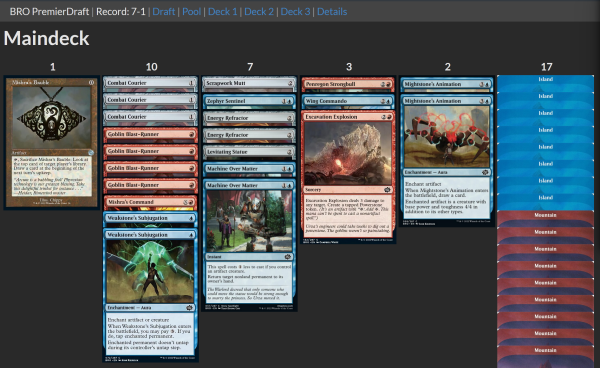
UR Blast-Runner Aggro
To the untrained eye, this might appear as a UR Spells deck. However, it boasts four copies of Goblin Blast-Runner. This one-drop has been a catalyst for many of the most aggressive decks in the format. Last week, we spent a lot of time discussing blue's top common, Combat Courier. The two one-drops play nicely and it's blue, not black, that is activating the extra power and menace on the goblin in this deck. This aggressive approach is supported by some of blue's cheap interaction and a couple of Mightstone's Animation at the top of the curve.
The Best Blue Decks - UR Spells and UW Soldiers
The seeded archetypes that blue should be proudest of are UR Spells and UW Soldiers. But as we identified in our preview guide, these archetypes really live at uncommon and rare. We can't turbo-charge these archetypes unless we open the few cards specifically worth building around. Fortunately for these players, that wasn't a problem.
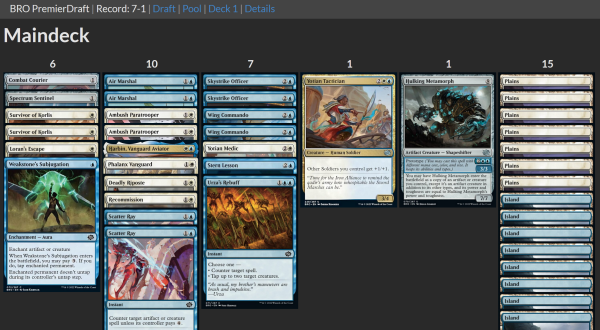
UW Soldiers
Double Skystrike Officer, Harbin, Vanguard Aviator, and a Yotian Tactician are signs that UW Soldiers was wide open. We don't need an excuse to get into these archetypes and when they're open we should treat them like realistic options even without the embarrassment of riches we see in this pool. This deck leverages its lords with a number of one drops to be as aggressive as possible. As a support color, blue doesn't offer many aggressive creatures, but in this deck, it borrows nicely from white to build an aggressive game plan.
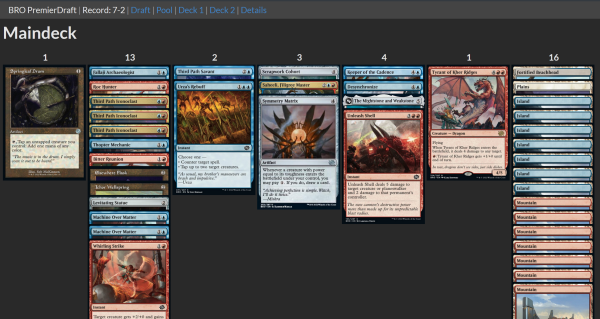
Triple Iconoclast UR Spells
The headline here is triple Third Path Iconoclast. Both that uncommon and the colorless Levitating Statue are great reasons to be in this archetype.
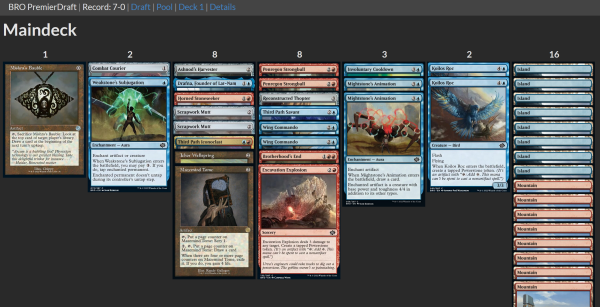
UR Spells
This UR Spells deck goes a little bit bigger. It takes advantage of Koilos Roc and Mightstone's Animation to close out games. While this deck doesn't have the triple Third Path Iconoclast or double Skystrike Officer, the high card quality and powerful card advantage engines for the end game can close out games while presenting threats at lower rarities.
In these decks, we see more of the blue commons. While they're not the most powerful individual cards, they help us to round out powerful decks. If we're relying on blue as the main color, we need to anticipate that some of our cards will be a little bit weaker. We need to ensure that those cards help to facilitate our plan, because they certainly don't make for stand-alone all-stars.
Battery Bearer Proof of Concept
UG Ramp is the least productive archetype thus far in BRO. We need the ramp, the payoffs, and a way to survive into the late game. Once there, we need to make sure we have the card advantage to win. These two decks have all of those pieces while using the signpost uncommon to live the UG Ramp dream.
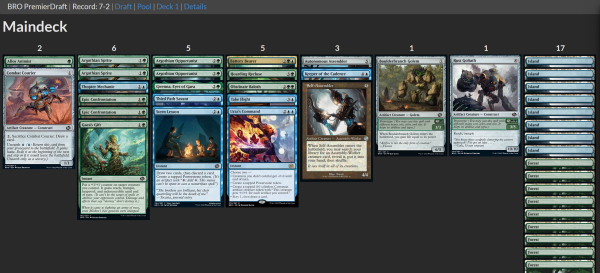
UG Ramp - Midrange
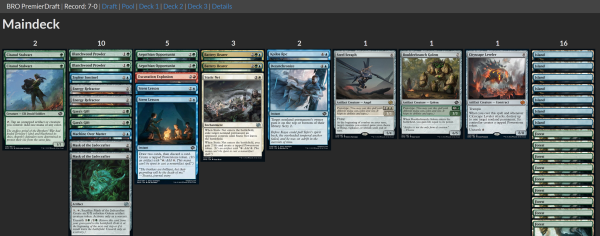
UG Ramp - Control
These decks have top-end threats to maximize the mana boost we get from Battery Bearer. They also get a lot of value off of Stern Lesson, as both decks need more than one top-end threat to win the game. The first deck is more midrange and threatens the opponent with powerful three and four-drop plays. The second deck is a little more all-in on the ramp strategy. The double Citanul Stalwart plan backs up the two Battery Bearers to race to the mythic threats waiting at the top of the curve, and it uses more removal to get there.
Going Blue for the Right Reasons

Looking at those decks, the following principles materialized as a road map for working toward a blue deck.
- Do not go into blue for commons. Some of the cards are individually fine, and investing in an open color may yield dividends late, but we really want to see rares and uncommons before we jump into blue as a central color.
- ...but it does not need to be the central color. If we find that a color is really open then cherry-picking premium blue cards is a good way to round out a strong deck.
- UR Spells and UW Soldiers are just good decks. While I'm still wary about committing to blue, if these decks look open, we can speculate on blue cards. The red spells pivot into other colors better than the white aggressive creatures (which only really pivot into red).
- UG Ramp is an archetype you can build, but Battery Bearer is not the sign we're waiting for. If we see premium green commons, expensive bombs, and blue cards of enticing power level, go for it. However, the data is concerning, and for good reason.
- In Dominaria United, we identified black and red as support colors. However, those colors added similar elements to most of the decks they touched. Essentially, red made the deck more aggressive and black made the deck more controlling. In BRO, blue's impact is more varied. It can help with card advantage and situation interaction. It has some tempo cards or can help boost our spell count for decks that care about that. Blue unlocks archetypes like draw-two or soldiers. In short, blue can do a lot of different things, it just isn't great at any of them.
- Of all the blue cards in the format, it's a small group of cards that show up in these decks. While this is only a snapshot of what blue can do in the format, there are only a couple of commons that show up consistently. Most are relegated to their niche archetypes.
Shine a Little Light
To close out our article today we're going to look at an unexpected uncommon. This card doesn't boast an impressive GIH WR (52.5%) and it has gotten more attention for what it does in Constructed than Limited. Still, I think the format has a spot for this oft-overlooked discard spell.
Duress style effects don't typically thrive in Booster Drafts. Limited decks are less dependent on individual cards, and trading one for one, when we're paying the mana, isn't great. However, this card seems like a valuable tool in this format.
While it will inevitably be a horrible top deck at some point in the game, I still like its upside. Discard is typically a liability against aggressive decks, but because of how important the card advantage from unearthing is to those aggressive decks, we may find a window for this to be a meaningful two-for-one. Additionally, this can help snag a prototype monster or rare creature from our opponent's hand and exile matters.
Black struggles in this format because it can't keep up with the early aggression. While trading cards at a mana disadvantage won't help that issue, snagging an early play can disrupt our opponent's curve. Furthermore, black doesn't use its mana efficiently on early turns, making it less of a cost. This card may have a spot in the grindier black decks in the format, like UB Control, or even some versions of BR Sacrifice.


